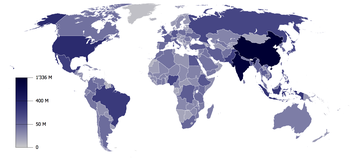Population development
Population development describes the development of the number of people ( inhabitants ) on a certain area. On the one hand, it results from the difference between the birth rate and the death rate (natural population development) . Then there is the migration balance . This results from the difference between immigration and emigration across the area border. Depending on the sign of the total balance, one speaks of population growth or population decline . The population development is one of the central research areas of demography .
Characteristic for the population development of the world (the world population ), in particular that of the last 200 years, was a strong hyperexponential growth , which is why one speaks of population explosion . Since the turning point in 1962/63, however, the growth rate has declined and, since 1989, so has the absolute increase.
Due to its negative influence on the limited carrying capacity of the earth (see also ecological footprint ) and its multiplier function for all human activities that conflict with sustainable development , population growth is one of the central global problems and is jointly responsible for global warming .

introduction
Basic demographic equation
As already explained at the beginning, the population development results on a geographical area
- from the natural population development , i.e. the changes due to the number of births and deaths ( birth rate and death rate ) and
- from the migration balance , i.e. the difference between immigration and emigration ( immigration and emigration ) across regional boundaries.
These values are movement quantities ; In general, the following applies: "Stock size of the previous year ± movement size = current stock size".
Growth rates and doubling period
The extent of population growth is expressed as a growth rate in percent (usually based on a year). With a growth rate of 1.14 percent per year - corresponding to the estimated global growth rate in 2006 - it takes about 61 years for the population to double - provided that growth remains constant at that level all the time. If the annual growth rate is 2%, the doubling time is reduced to 35 years. At a rate of 3.5%, which is reached or exceeded in some countries, the doubling time is only 20 years (see also the 72 rule ).
Course of population development
Historical development
In 1798 the scientist Thomas Robert Malthus examined the relationship between population growth and soil yield and came to the prognosis that the soil yield could only grow in arithmetic progression (1, 2, 3, 4, 5 etc.), but the population could grow in geometric progression (1, 2, 4, 8, 16 etc.) grow, with the result of hunger and poverty . It was not improvements in production but birth control (for example through abstinence ) that the Pastor Malthus saw as a way of permanently fighting poverty. It was not until John Stuart Mill , in 1848, that this population theory was supported with the law of decreasing land yield . Neomalthusianism , influenced by Mill, promoted birth control contraceptives , which Malthus had rejected. Their statistical forecasts are now largely verified , as the population development shows.
At the turn of the ages there were fewer than 200 million people on earth, in 1650 there were around 500 million. In 1650 the growth rate was 0.3%. After the strong growth rates during the industrial revolution , the population had already more than tripled to 1.6 billion by 1900. At that time it increased by 0.7 to 0.8% annually, which corresponds to a doubling time of around 100 years. In 1965 it actually doubled (to 3.3 billion people); the growth rate at that time was 2 percent (doubling period: 36 years). The earth's population grew super exponentially in years when the growth rate increased . The main reason for this trend was the sharp fall in the death rate with only a slow fall in the birth rate. This development was made possible primarily by the considerable increases in yields of an increasingly technical agriculture, the industrial production of nitrogen fertilizers and its use since the Second World War, as well as the successes of the so-called Green Revolution . From the 1950s onwards, there was a controversial debate as to whether there was a threat of overpopulation . From 1965 to 2000 the population rose from 3.3 billion to six billion. What has been striking since the 1950s, however, is the sharp fall in the birth rate (in the 1950s a woman gave birth to an average of five children; in the 1990s it was only 2.7). The falling birth rate caused the growth rate of the world population to drop from 2.0% to 1.2%. The absolute growth in the world population has remained almost constant since the 1970s, as Table 1 shows. The number of children aged 0 to 14 worldwide rose from under 1 billion to almost 2 billion between 1950 and 2000 and remained almost stable in the following years.
| year | Population (in billions) |
Growth rate (% per year) |
Growth (million per year) |
Average age |
|---|---|---|---|---|
| 1950 | 2.53 | 1.8 | 47.1 | 23.5 |
| 1960 | 3.03 | 1.9 | 60.6 | 22.7 |
| 1970 | 3.69 | 2.0 | 76.0 | 21.5 |
| 1980 | 4.45 | 1.8 | 82.9 | 22.6 |
| 1990 | 5.32 | 1.5 | 84.2 | 24.1 |
| 2000 | 6.13 | 1.2 | 77.3 | 26.3 |
| 2010 | 6.92 | 1.2 | 81.7 | 28.5 |
| 2020 2 | 7.72 | 0.9 | 73.3 | 31.0 |
| 2030 2 | 8.42 | 0.7 | 63.7 | 33.2 |
| 2040 2 | 9.04 | 0.6 | 54.0 | 34.6 |
| 2050 2 | 9.55 | 0.5 | 43.1 | 36.1 |
Characteristics
Demographic transition
The course of the world population as well as the course of the population figures of individual countries shows a typical course of the change in birth and death rates and the resulting course of growth. This model is called the demographic transition and has five phases, as illustrated in Figure 2:
- Phase: In the initial phase, both the birth rate and the death rate are high, while the population growth rate is relatively low and constant.
- Phase: If nutrition and medical care improve, the death rate initially falls. However, the birth rate is still consistently high for a generation or two, which increases the spread between birth and death rates, which in turn leads to a strong increase in the overall growth rate.
- Phase: By improving the way of life and changing habits, the birth rates finally fall, as is typically the case in industrial societies. As a result, the range becomes smaller again and population growth slows down.
- Phase: The death rate has reached a consistently low level and can hardly be reduced. Meanwhile, the birth rate continues to decrease, which leads to a further decrease in the growth rate.
- Phase: the birth and death rates have leveled off at a constantly low level, the growth rate is again as constant as in phase 1.
In addition, the birth rate may develop lower than the death rate, which may lead to a negative growth rate, i. H. the population would decrease overall.
It is important to remember that a decrease in the growth rate does not mean a decrease in the total population; A decrease in the growth rate only means a less strong increase in the total population.
Regional differences
Population growth in the world varies significantly (see Figure 3). In particular, one has to distinguish between the developing and the industrialized countries . The following tables 2 and 3 show the numerical values of the ten most populous developing and emerging countries and the four most populous industrialized countries. The absolute annual growth rates in developing countries are high, but they are falling. If you compare Figures 3 and 5, you can see that the poorest countries in the world also have the highest growth rates. This relates primarily to Africa south of the Sahara , Pakistan , Bangladesh , Indonesia and the Philippines . The latter four are already among the ten most populous countries in the world, as Table 2 shows. As the most populous country in the world, China is a special case due to its one-child policy . The growth rate is therefore relatively low for a developing country, but the absolute growth is still almost seven million per year.
| State (name) |
Population (in millions) |
Growth rate (in%) |
Fertility (births per woman) |
Growth (million per year) |
|---|---|---|---|---|
|
|
95.9 | 2.1 | 4.1 | 2.0 |
|
|
158.5 | 1.5 | 2.2 | 2.4 |
|
|
202.8 | 0.9 | 1.8 | 2.4 |
|
|
1364.1 | 0.5 | 1.6 | 6.8 |
|
|
1296.2 | 1.5 | 2.4 | 19.4 |
|
|
251.5 | 1.4 | 2.6 | 3.5 |
|
|
119.7 | 1.4 | 2.2 | 1.7 |
|
|
177.5 | 2.5 | 5.6 | 4.4 |
|
|
194.0 | 2.0 | 3.8 | 3.9 |
|
|
100.1 | 1.8 | 3.0 | 1.8 |
| State (name) |
Population (in millions) |
Growth rate (in%) |
Fertility (births per woman) |
Growth (million per year) |
|---|---|---|---|---|
|
|
82.79 | 0.4 | 1.5 | 0.05 |
|
|
127.1 | −0.2 | 1.4 | −0.3 |
|
|
143.7 | 0 | 1.7 | 0 |
|
|
317.7 | 0.4 | 1.9 | 1.3 |
urbanization
The world's population is growing mainly in the cities of developing countries. In 1975 about 37% of the world population lived in cities, in 2009 it was more than 50% for the first time with 3.3 billion. This number is expected to increase to around five billion by 2030. In Asia, Africa and Latin America, the urban population will have doubled within 30 years: in Asia from 1.36 to 2.59 billion, in Africa from 294 to 761 million and in Latin America and the Caribbean from 394 to 585 million.
One feature is the emergence of megacities with more than ten million inhabitants. While there were only five in 1975, there were already 28 in 2014 and there are expected to be 41 in 2030, the vast majority of them in Asia and Latin America. Overall, the urban population is currently growing by around 60 million annually.
The following table 4 shows the population development of today's megacities between 1955 and 2005. The development of cities in emerging and developing countries such as São Paulo ( Brazil ), Mumbai , Delhi and Calcutta ( India ), Karachi ( Pakistan ), whose population numbers are increasing, is particularly extreme at least tripled and in some cases even fifteen-fold in 50 years. The population of Dhaka even increased thirty- fold.
| city | country | 1955 | 1965 | 1975 | 1985 | 1995 | 2005 | 2014 | 2030
(Estimate) |
|---|---|---|---|---|---|---|---|---|---|
| Tokyo (metropolitan area) |
|
13.7 | 20.3 | 26.6 | 30.3 | 33.6 | 35.6 | 37.8 | 37.2 |
| Mexico city |
|
3.8 | 6.7 | 10.7 | 14.1 | 16.8 | 18.7 | 20.8 | 23.9 |
| Istanbul |
|
1.2 | 1.7 | 2.5 | 5.4 | 8.2 | 9.7 | 14.0 | 16.7 |
| New York City (metropolitan area) |
|
13.2 | 15.1 | 15.9 | 15.8 | 16.9 | 18.7 | 18.6 | 19.9 |
| São Paulo |
|
3.0 | 5.5 | 9.6 | 13.4 | 15.9 | 18.7 | 20.8 | 23.4 |
| Mumbai (Bombay) |
|
3.4 | 4.9 | 7.1 | 10.3 | 14.1 | 18.2 | 20.7 | 27.8 |
| Delhi |
|
1.8 | 2.8 | 4.4 | 6.8 | 10.0 | 19.5 | 25.0 | 36.0 |
| Shanghai |
|
6.3 | 6.8 | 7.3 | 7.9 | 10.4 | 15.2 | 20.8 | 30.8 |
| Calcutta |
|
5.1 | 6.3 | 7.9 | 9.9 | 11.9 | 14.3 | 14.8 | 19.1 |
| Buenos Aires |
|
5.8 | 7.3 | 8.7 | 9.9 | 11.2 | 12.6 | 15.0 | 17.0 |
| Dhaka |
|
0.4 | 0.8 | 2.2 | 4.7 | 8.3 | 12.6 | 17.0 | 27.4 |
| Los Angeles (-Long Beach-Santa Ana) |
|
5.2 | 7.4 | 8.9 | 10.2 | 11.3 | 12.3 | 12.3 | 13.3 |
| Karachi |
|
1.4 | 2.4 | 4.0 | 6.0 | 8.5 | 11.6 | 16.1 | 24.8 |
| Rio de Janeiro |
|
3.6 | 5.4 | 7.6 | 9.1 | 10.2 | 11.4 | 12.8 | 14.2 |
| Cairo |
|
3.0 | 4.7 | 6.5 | 8.3 | 9.7 | 10.6 | 18.4 | 24.5 |
| Peking (Beijing) |
|
4.6 | 5.3 | 6.0 | 6.9 | 8.5 | 11.5 | 19.5 | 27.7 |
| Osaka - Kobe |
|
5.1 | 7.7 | 9.8 | 10.4 | 11.1 | 11.3 | 20.1 | 20.0 |
| Manila |
|
1.9 | 2.8 | 5.0 | 6.9 | 9.4 | 10.8 | 12.8 | 16.8 |
| Moscow |
|
5.8 | 6.6 | 7.6 | 8.6 | 9.2 | 10.4 | 12.1 | 12.2 |
| Paris |
|
6.8 | 8.0 | 8.6 | 9.0 | 9.5 | 10.1 | 10.8 | 11.8 |
Public discourse
Robert Engelman, President of the Worldwatch Institute , stated in 2013 that the growth of the world population in the last few decades had hardly been mentioned in public discourse and government policy.
It is true that advocates of a pro-active population policy have long pointed out that the resources of planet earth are limited and that, if the growth of the world population does not end, diseases, hunger and armed conflicts would lead to ever more deaths. But world leaders have an unspoken agreement not to mention this issue because it is too sensitive. They fear angering poorer and more populous states and religious groups such as the Catholic Church (whose influence on Filipino law on contraception is cited as an example), who in turn would argue that the much higher resource consumption of the rich is a greater threat than the high birth rates.
See also
- Summarized fertility rate
- List of states and territories according to population development
- Leslie matrix
- German Foundation for World Population
literature
- Yearbook 2004 - numbers, data, analyzes. Spiegel, Hamburg 2004, ISBN 3-423-32004-4 .
- Federal Agency for Civic Education (BpB): Social Problems - Population Growth. (PDF; 185 kB).
- World Population Foundation: Data Report 2014 - Social and Demographic Data Worldwide (PDF; 0.60 MB).
- Federal Ministry of Education and Research (BMBF): Funding priority research for the sustainable development of the megacities of tomorrow.
- Claus D. Kernig: And multiply? Germany and the world population in the 21st century. Dietz, Bonn 2006, ISBN 3-8012-0361-1 .
- Bettina Rainer: Population growth as a global catastrophe. Westphalian steam boat, Münster 2005, ISBN 3-89691-582-7 .
- Rainer Münz, Albert F. Reiterer: How fast is the number of people growing? World population and global migration. Fischer, Frankfurt am Main 2007, ISBN 978-3-596-17271-9 .
- Danny Dorling : Population 10 Billion: The Coming Demographic Crisis and How to Survive It . London: Constable, 2013
- Stephen Emmott : Ten Billion . New York: Penguin, 2013, ISBN 978-0-345806475
Web links
- Population development. In: Handbook of the Berlin Institute for Population and Development.
- Country-by-country growth rates. In: CIA World Factbook. (English)
- Online country database of the World Population Foundation on demographic issues
- World Population Prospects: The 2015 Revision United Nations, Department of Economics and Social Affairs
- Population growth rate (percentage) table from the UNdata database
- Graphic: Worldwide population development , from: Figures and facts: Globalization , Federal Agency for Civic Education / bpb
- Graphic: Population development by region , from: Figures and facts: Globalization , bpb.de
- Graphic: World population projections up to 2100 , World Population Foundation
Individual evidence
- ^ Thomas Robert Malthus : An Essay on the Principle of Population , 1798, p. 8
- ^ John Stuart Mill : Principles of Political Economy , Volume III, 1848, p. 7
- ^ Wilhelm Fucks : Population growth - standstill in 70 years. In: Der Spiegel 18 (1954)
- ^ Wilhelm Fucks : Population growth - standstill in 70 years. In: Formulas for Power . Deutsche Verlags-Anstalt, Stuttgart 1965, 4th revised edition 1970. Rowohlt, Reinbek b. Hamburg, ISBN 3-499-16601-1 .
- ^ A b Donella Meadows , Jørgen Randers , Dennis L. Meadows : Limits to Growth - The 30-Year Update: Signal to Change Course . S. Hirzel Verlag, Stuttgart, 2011, ISBN 3-7776-2228-1
- ↑ Population development: data, facts, trends on demographic change. (No longer available online.) Federal Institute for Population Research (BiB), 2016, archived from the original on March 25, 2018 ; accessed on March 25, 2018 . Section “Development of the world population by age group, 1950 to 2015”, p. 77.
- ↑ World Population Prospects: The 2012 Revision. Retrieved October 19, 2014 .
- ↑ a b data report 2014 . World Population Foundation. August 1, 2014. Retrieved October 17, 2014.
- ↑ UN Populations Division: World Urban Prospects. The 2009 Revision Population Database . Accessed June 29, 2011.
- ↑ a b World Urbanization Prospects 2014 Revision (PDF; 5.13 MB; English)
- ↑ Robert Engelman, "Our Overcrowded Planet: A Failure of Family Planning," June 24, 2013






